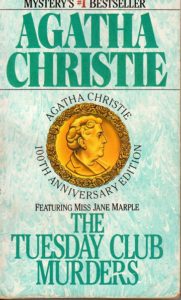Book Review: The Tuesday Club Murders by Agatha Christie
Author Raymond West has what he thinks is a smashing idea. A series of Tuesday night gatherings where the six people present discuss mysteries they’ve run across, particularly juicy murders. In addition to himself, there’s an artist, a lawyer, a clergyman, a retired Scotland Yard commissioner, oh, and his Aunt Jane. She’s a darling maiden aunt who has seldom left her home village, and is obsessed with knitting, but she might have an insight or two. But he needn’t have worried about her falling behind, for Miss Marple knows a thing or two about human nature.
Agatha Christie’s beloved elderly lady of detection first appeared in these short stories beginning in 1927. The collection of them in a book (originally titled The Thirteen Problems) didn’t happen until 1932, so The Murder at the Vicarage (1930) is the first Miss Marple book. The format of the first six stories is the Tuesday night meetings, beginning with “The Tuesday Night Club” and ending with “The Thumb Mark of St. Peter.” Then Sir Henry Clithering, the retired Scotland Yard man, gets Miss Marple invited to a dinner party where six more mysteries are told, from “The Blue Geranium” to “The Affair at the Bungalow.”
The last story, “Death by Drowning” has Miss Marple ask Sir Henry to look into a young woman’s apparent suicide–she’s figured out what actually happened, but has no proof.
Miss Marple’s primary method is finding analogies. Although she has seldom left her largish village of St. Mary Mead, Aunt Jane has had a long life and a keen interest in the people around her (and an ear for gossip.) Thus she can almost always find something in her past that is reminiscent of the case at hand, and gives her the clues she needs.
Despite the title, not all of the stories involve a murder; “Ingots of Gold” for example is about a robbery. Some of the tales may be more difficult for a reader to unravel due to them becoming dated; one relies on older British slang, while another requires a knowledge of obsolete work practices. On the other hand, one of the tales has a trick ending of the type that made Ms. Christie’s work famous. There’s some period sexism and classism, and one story involves domestic abuse.
While not Agatha Christie’s best work, and Miss Marple would have some character development in later books, (she’s kind of smug here) these are fun short mysteries that are very much of a time and place.

